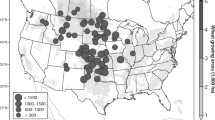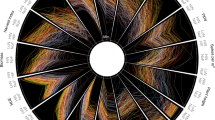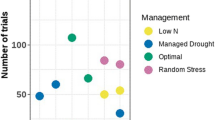Abstract
The International Maize and Wheat Improvement Center develops and annually distributes elite wheat lines to public and private breeders worldwide. Trials have been created in multiple sites over many years to assess the lines’ performance for use in breeding and release as varieties, and to provide iterative feedback on refining breeding strategies1. The collaborator test sites are experiencing climate change, with new implications for how wheat genotypes are bred and selected2. Using a standard quantitative genetic model to analyse four International Maize and Wheat Improvement Center global spring wheat trial datasets, we examine how genotype–environment interactions have changed over recent decades. Notably, crossover interactions—a critical indicator of changes in the ranking of cultivar performance in different environments—have increased over time. Climatic factors explained over 70% of the year-to-year variability in crossover interactions for yield. Yield responses of all lines in trial environments from 1980 to 2018 revealed that climate change has increased the ranking change in breeding targeted to favourable environments by ~15%, while it has maintained or reduced the ranking change in breeding targeted to heat and drought stress by up to 13%. Genetic improvement has generally increased crossover interactions, particularly for wheat targeted to high-yielding environments. However, the latest wheat germplasm developed under heat stress was better adapted and more stable, partly offsetting the increase in ranking changes under the warmer climate.
This is a preview of subscription content, access via your institution
Access options
Access Nature and 54 other Nature Portfolio journals
Get Nature+, our best-value online-access subscription
$29.99 / 30 days
cancel any time
Subscribe to this journal
Receive 12 digital issues and online access to articles
$119.00 per year
only $9.92 per issue
Buy this article
- Purchase on Springer Link
- Instant access to full article PDF
Prices may be subject to local taxes which are calculated during checkout




Similar content being viewed by others
Data availability
The original IWIN nursery data are publicly available at https://data.cimmyt.org. The climate data are from the European Centre for Medium-Range Weather Forecast (https://www.ecmwf.int). The cleaned nursery data and corresponding climate information prepared for this study are available at https://doi.org/10.7910/DVN/E3UF3R.
Code availability
The data analysis scripts, including trend analysis, regression and plotting, were developed with Python v.3.7.3 and were deposited in GitHub (https://github.com/WeiXiong88/WheatGbyE). Requests for analysis scripts for the analyses performed can be directed to W.X.
References
Reynolds, M. P. et al. Improving global integration of crop research. Science 357, 359–360 (2017).
Braun, H., Atlin, G. & Payne, T. Multi-location testing as a tool to identify plant response to global climate change. in Climate Change and Crop Production (ed. Reynolds, M. P.) 115–138 (CABI, 2010).
Ray, D. K., Ramankutty, N., Mueller, N. D., West, P. C. & Foley, J. A. Recent patterns of crop yield growth and stagnation. Nat. Commun. 3, 1293 (2012).
Liu, B. et al. Similar estimates of temperature impacts on global wheat yield by three independent methods. Nat. Clim. Change 6, 1130–1136 (2016).
Lobell, D. B. & Field, C. B. Global scale climate–crop yield relationships and the impacts of recent warming. Environ. Res. Lett. 2, 14–21 (2007).
Asseng, S. et al. Rising temperatures reduce global wheat production. Nat. Clim. Change 5, 143–147 (2015).
Crespo-Herrera, L. A. et al. Genetic yield gains in CIMMYT’s international elite spring wheat yield trials by modeling the genotype × environment interaction. Crop Sci. 57, 789–801 (2017).
Tester, M. & Langridge, P. Breeding technologies to increase crop production in a changing world. Science 327, 818–822 (2010).
Rosegrant, M. W. & Cline, S. A. Global food security: challenges and polices. Science 302, 1917–1919 (2003).
Li, Y., Suontama, M., Burdon, R. D. & Dungey, H. S. Genotype by environment interactions in forest tree breeding: review of methodology and perspective on research and application. Tree Genet. Genomes 13, 60 (2017).
Mishra, R. M. et al. Crossover interactions for grain yield in multienvironmental trials of winter wheat. Crop Sci. 46, 1291–1298 (2006).
Allard, R. W. & Bradshaw, A. D. Implications of genotype–environmental interactions in applied plant breeding. Crop Sci. 4, 503–508 (1964).
Reynolds, M. P., Hays, D. & Chapman, S. Breeding for adaptation to heat and drought stress. in Climate Change and Crop Production (ed. Reynolds, M. P.) 71–91 (CABI, 2010).
Leon, N., Jannink, J., Edwards, J. W. & Kaeppler, S. M. Introduction to a special issue on genotype by environment interaction. Crop Sci. 56, 2081–2089 (2016).
Reynolds, M. & Langridge, P. Physiological breeding. Curr. Opin. Plant Biol. 31, 162–171 (2016).
Gourdji, S. M., Mathews, K. L., Reynolds, M., Crossa, J. & Lobell, D. B. An assessment of wheat yield sensitivity and breeding gains in hot environments. Proc. R. Soc. B. 2018, 20122190 (2012).
Pingali, P. L. Green revolution: impacts, limits, and the path ahead. Proc. Natl Acad. Sci. USA 109, 12302–12308 (2012).
Sharma, R. C. et al. Genetic gains for grain yield in CIMMYT spring bred wheat across international environment. Crop Sci. 52, 1522–1533 (2012).
Boehm Jr, J. D., Ibba, M., Kiszonas, A. & Morris, C. F. End-use quality of CIMMYT-derived soft kernel durum wheat germplasm. II. Dough strength and pan bread quality. Crop Sci. 57, 1485–1498 (2017).
Lillemo, M., van Ginkel, M., Trethowan, R. M., Hernandez, E. & Crossa, J. Differential adaptation of CIMMYT bread wheat to global high temperature environments. Crop Sci. 45, 2443–2453 (2005).
Manes, Y. et al. Genetic yield gains of the CIMMYT international semi-arid wheat yield trials from 1994 to 2010. Crop Sci. 52, 1543–1552 (2012).
You, L. et al. Spatial Production Allocation Model (SPAM) 2005 V3.2 International Food Policy Research Institute (IFPRI), International Institute fo Applied Systems Analysis (IIASA) (2017).
Finlay, K. W. & Wilkinson, G. N. The analysis of adaptation in a plant-breeding programme. Aus. J. Agric. Res. 14, 742–754 (1963).
De los Campos et al. A data-driven simulation platform to predict cultivars’ performance under uncertain weather conditions. Nat. Commun. 11, 4876 (2020).
Lantican, M. A. et al. Impacts of International Wheat Improvement Research 1994–2014 (CIMMYT, 2016).
Dreccer, M. F., Bonnett, D. & Lafarge, T. Plant breeding under a changing climate. in Encyclopedia of Sustainability Science and Technology (ed. Meyers, R. A.) 8013–8024 (Springer, 2012).
Laiding, F., Drobek, T. & Meyer, U. Genotypic and environmental variability of yield for cultivars from 30 different crops in German official variety trials. Plant Breed. 127, 541–547 (2008).
Allard, R. W. Principles of Plant Breeding 2nd edn (John Wiley & Sons, 1999).
Kusmec, A., Srinivasan, S., Nettleton, D. & Schnable, P. S. Distinct genetic architectures for phenotype means and plasticities in Zea mays. Nat. Plants 3, 715–723 (2017).
Gauch, H. G. Statistical Analysis of Regional Yield Trials: AMMI Analysis of Factorial Designs (Elsevier, 1992).
Acknowledgements
This work was supported by projects funded by the National Natural Science Foundation of China (grant nos. 4147104 and 41171093) and the project granted by the Foundation for Food and Agriculture Research. This study was also supported by the CGIAR research programme on wheat agri-food systems (CRP WHEAT) and the CGIAR Platform for Big Data in Agriculture. We thank T. Lin, D. Wang, T. Guo and others from the HAU for discussions on the methods and results of this study, and Z. He from the Chinese Academy of Agricultural Sciences for assistance in obtaining the data.
Author information
Authors and Affiliations
Contributions
M.P.R., W.X. and J.C. conceived the study. T.P., U.S., K.S., C.M. and N.A. collected and processed the data. W.X. analysed the data. W.X. and M.P.R. wrote the paper, and all authors contributed to the writing.
Corresponding author
Ethics declarations
Competing interests
The authors declare no competing interests.
Additional information
Peer review information Nature Plants thanks Marta Da Silva, J. W. White and the other, anonymous, reviewer(s) for their contribution to the peer review of this work.
Publisher’s note Springer Nature remains neutral with regard to jurisdictional claims in published maps and institutional affiliations.
Extended data
Extended Data Fig. 1 Temporal changes in yield variance.
Yield variance caused by germplasm (a) and environment (b). Yield variances (points) were estimated by the ANOVA method and converted to the precent relative to the regression values for the first year. The lines are linear regression fits estimated by the least squares method, with shading representing the respective 95% confidence intervals.
Extended Data Fig. 2 Changes in the six climatic variables averaged across testing sites in three stages of the growing season.
Veg. vegetative; rep. reproductive; gfi. grain filling. The lines are linear regression fits.
Extended Data Fig. 3 Changes in the variation of the six climatic variables among the sites.
Veg. vegetative; rep. reproductive; gfi. grain filling. The lines are linear regression fits.
Extended Data Fig. 4 Simulation sensitivity to model’s parameters.
Response of simulated yield and crossover occurrence to L1 penalty coefficient of the Lasso regression.
Extended Data Fig. 5 Possibility of crossover occurrence across environment.
Each bin of the histgram represents the ocurrence possibility of crossover in specific site mean yields.
Extended Data Fig. 6 Result sensitivity to the choosing of yield variation – climate relationship models.
Results only show the trends of crossover occurrence caused by climate change.
Extended Data Fig. 7 Reported wheat yield and changing trends for each of the four nurseries.
The lines are linear regression fits estimated by the least squares method, with shading representing the respective 95% confidence intervals. Points are reported mean yield for each line and year.
Supplementary information
Supplementary Information
Supplementary Methods, Figs. 1–4, Tables 1–4 and References.
Rights and permissions
About this article
Cite this article
Xiong, W., Reynolds, M.P., Crossa, J. et al. Increased ranking change in wheat breeding under climate change. Nat. Plants 7, 1207–1212 (2021). https://doi.org/10.1038/s41477-021-00988-w
Received:
Accepted:
Published:
Issue Date:
DOI: https://doi.org/10.1038/s41477-021-00988-w
This article is cited by
-
Spatiotemporal co-optimization of agricultural management practices towards climate-smart crop production
Nature Food (2024)
-
Exotic alleles contribute to heat tolerance in wheat under field conditions
Communications Biology (2023)
-
Climate change impacts on crop yields
Nature Reviews Earth & Environment (2023)
-
Agricultural trade impacts global phosphorus use and partial productivity
Nature Food (2023)
-
Upcycling rice yield trial data using a weather-driven crop growth model
Communications Biology (2023)



